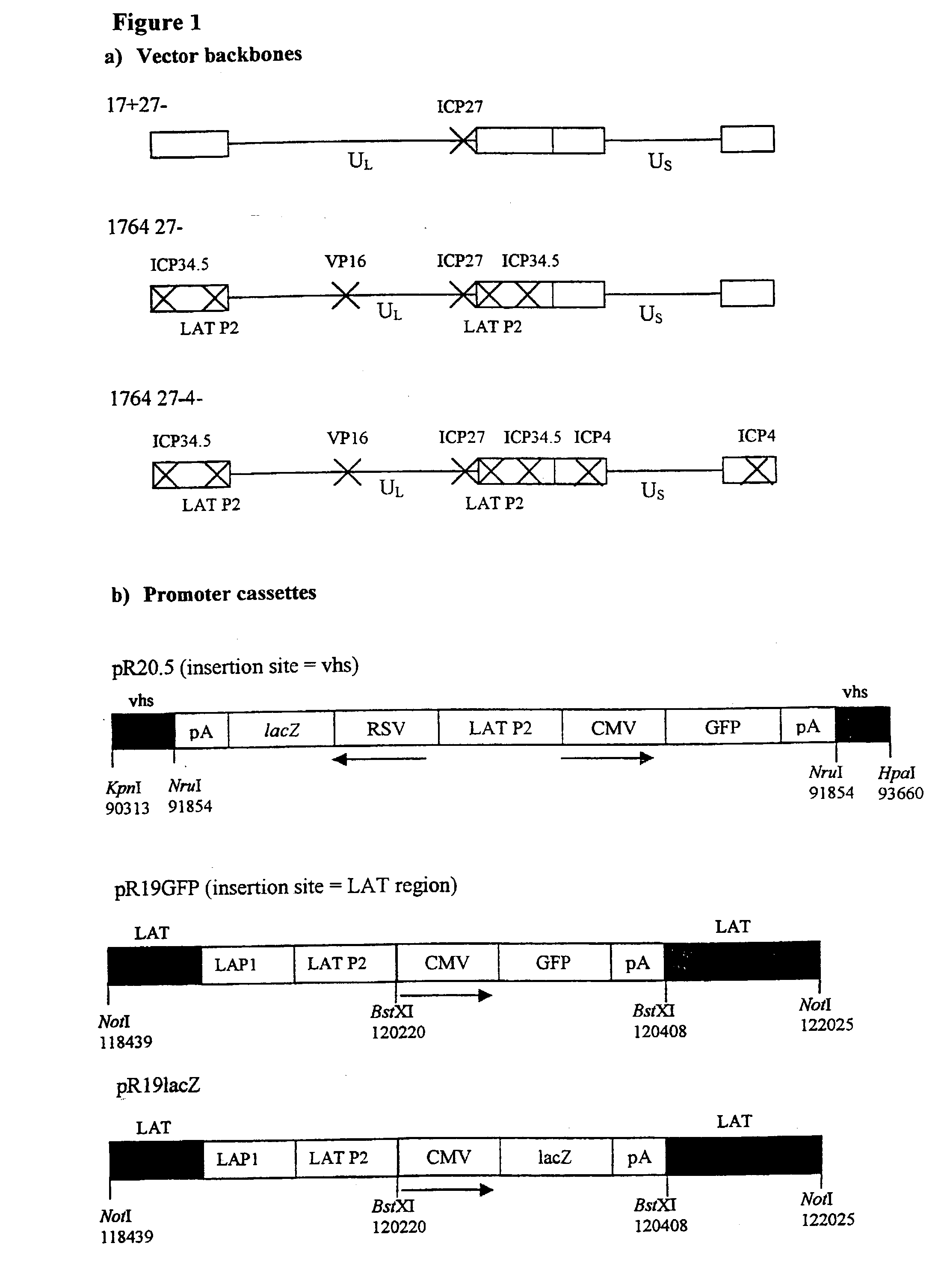Replication incompetent herpes viruses for use in gene therapy
- Summary
- Abstract
- Description
- Claims
- Application Information
AI Technical Summary
Benefits of technology
Problems solved by technology
Method used
Image
Examples
example 1
[0100] Replication incompetent HSV vectors containing a long-term promoter and deleted for ICP27 do not allow widespread gene delivery in the brain following inoculation at a single site.
[0101] 5 .mu.l of virus strain 17+ / pR19lacZ at a titre of 1.times.10.sup.8pfu / ml was inoculated into the striatum of 200-220 g female Lewis rats using stereotaxic procedures and a glass micropipette for inoculation. Virus suspension was administered at a rate of 0.5 .mu.l / min. Pairs of animals were perfusion fixed at either 3 days, 1 week or 1 month post-inoculation, and sectioned and stained with X-gal as previously described (Howard et al. 1998). Brain sections showed robust X-gal staining in the striatum at 3 days post-inoculation which had reduced to some extent by 1 week and which was evident in only small numbers of cells by 1 month. However there was no significant X-gal staining evident at sites in the brain connected to the striatum such as the substantia nigra, from which dopaminergic neur...
example 2
[0102] Replication incompetent HSV vectors vectors containing a short-term promoter, deleted for ICP27 and ICP4 and with an inactivating mutation in vmw65, do not allow widespread gene delivery in the brain following inoculation at a single site.
[0103] 5 .mu.l of virus strain 1764 / 27- / 4- / CMVlacZ / US5 at a titre of 1.times.10.sup.8pfu / ml was inoculated into the striatum of 200-220 g female Lewis rats using stereotaxic procedures as in Example 1. Pairs of animals were again perfusion fixed at either 3 days, 1 week or 1 month post-inoculation, and sectioned and stained with X-gal. Brain sections again showed robust X-gal staining in the striatum at 3 days post-inoculation which had reduced by 1 week and but which in this case was undetectable by 1 month post-inoculation. There was no X-gal staining evident at sites in the brain connected to the striatum at any of the time points tested. Therefore using a replication incompetent virus backbone in which immediate early gene expression has...
example 3
[0104] Replication incompetent HSV vectors vectors containing a long=term promoter, deleted for ICP27 and ICP4 and with an inactivating mutation in vmw65 allow gene delivery to multiple sites in the brain following inoculation to only a single site.
[0105] Injections into the rat striatum, spinal cord or superior colliculus were carried out with the 1764 / 27- / 4- / pR19lacZ. 5 .mu.l of virus strain 1764 / 27- / 4- / pR19lacZ at a titre of 1.times.10.sup.8pfu / ml was inoculated into the striatum of 200-220 g female Lewis rats as above and brains removed and sectioned at time points as before. Brain sections again showed high efficiency gene delivery in the striatum at 3 days post-inoculation with large numbers of X-gal staining cells also evident at 1 week and 1 month after inoculation. However, unlike in the previous Examples, significant X-gal staining was observed in the substantia nigra. Therefore using both a replication incompetent virus backbone in which IE gene expression has been minimi...
PUM
| Property | Measurement | Unit |
|---|---|---|
| time | aaaaa | aaaaa |
| central nervous system disorder | aaaaa | aaaaa |
| neurodegenerative disorder | aaaaa | aaaaa |
Abstract
Description
Claims
Application Information
 Login to View More
Login to View More - R&D
- Intellectual Property
- Life Sciences
- Materials
- Tech Scout
- Unparalleled Data Quality
- Higher Quality Content
- 60% Fewer Hallucinations
Browse by: Latest US Patents, China's latest patents, Technical Efficacy Thesaurus, Application Domain, Technology Topic, Popular Technical Reports.
© 2025 PatSnap. All rights reserved.Legal|Privacy policy|Modern Slavery Act Transparency Statement|Sitemap|About US| Contact US: help@patsnap.com

